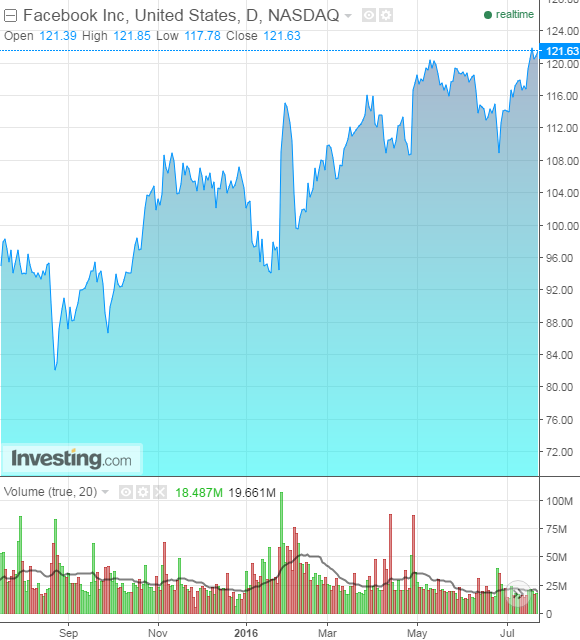by Clement Thibault
Facebook (NASDAQ:FB), the social media giant which operates mobile applications and a website, reports Q2 2016 earnings on Wednesday, July 27, after the market closes.

1. Revenue and earnings forecast
Consensus expectations for today's Facebook report are for an EPS of $0.81 on revenues of $5.99B. Last year, during the same quarter, Facebook reported $0.5 EPS on 4.04B revenue. With an anticipated 62% jump in EPS for this year and a 48% hike in revenue, Wall Street clearly continues to bank on Facebook reporting massive growth each quarter, by successfully monetizing their site. Last quarter, Facebook's EPS of $0.77 surprised investors, who were expecting an EPS of $0.62, driving up the stock by 10% in after-hours trade. Can Facebook repeat?
2. Only one metric counts
User growth is arguably the most important metric for social networks. Investors (often wrongly) expect years and years of double-digit growth. But that's a feat which is often difficult, indeed next-to-impossible to achieve over the long haul. As of last quarter, Facebook's daily active users (DAU)—meaning individuals who come to the site every single day—averaged 1.09 billion, 16% more than the previous year. And DAU growth between Q1 2014 to Q1 2015 was exactly the same, 16%.
Adding millions of daily users over the next quarter (or even quarters) is no easy trick under any circumstance, but the bigger Facebook becomes, the harder it will be for growth to continue at this pace. Though the company has been a bit vague about specifics, Facebook's DAUs on desktops actually decreased last quarter, making its growth entirely dependent on mobile users, with two key regions in the spotlight—Brazil and India.
Facebook has admitted it anticipates its active user growth rate to continue to decline, making revenue growth dependent on increasing levels of engagement and alternative routes to monetization. Facebook, by its own admission, is starting to reach the limits of its expansion capabilities. So the focus going forward will have to be monetization, and growth from that direction will be more difficult than many assume.
3. Monetization via advertising
The business side of Facebook is all about advertising. Of the $5.38B revenue reported last quarter, a colossal 97% of it came from advertising. For the same quarter a year previous, advertising brought in 94% of revenues.
If advertising is so crucial to Facebook's well-being—and it obviously is—what to anticipate for Q2 and going forward? One important metric to be aware of is regional difference in Facebook advertising rates. For instance, though North American users make up only about 13% of Facebook's monthly active users, they represent just a little over 50% of Facebook's revenue. The ARPU, or Average Revenue per User, for North Americans is more than $12 per person, compared to just under $4 in Europe and less than $1.50 in Asia. Latin America's ARPU is lumped into the company's 'rest of the world' category at $0.91 per user.
Regarding growth, there are two primary ways to increase revenue from advertising. Increasing the quantity of advertising displayed is one way to do this; The other is raising the cost per ad for customers. This is where it gets a bit dicey. In Q1, Facebook surprised with strong earnings, a result of two factors: the number of ads delivered increased by 50% while at the same time the price per ad went up by 5%.
That might be good for the books, but it also means that Facebook is now showing users 50% more advertising than it did a year ago. This 50% increase in ads delivered raises the important question of diminishing returns. How many more ads can Facebook push in front of users before fatigue, and worse, apathy undermine the endeavor? Luckily, the very nature of Facebook's product allows for pin-point targeting, delivering to advertisers the precise audience they request.
That's a benefit that could stave off declines for a while. However, we have strong doubts regarding Facebook's longer-term ability to garner significant revenue from existing users, as it did in Q1.
4. Additional platforms
Aside from Facebook itself, the company manages additional stand-alone, or parallel social networks, such as Facebook Messenger, Instagram, and WhatsApp. Both messaging apps—FB Messenger and WhatsApp—represent more than 1 billion monthly users apiece. Instagram represents an additional 500 million monthly users.
This past winter, Instagram rolled out advertising in its app, which has been successful so far. It's the second largest revenue driver after Facebook's main app. The company is relying on Instagram growing bigger, since continued monetization via this channel would be simple and straightforward given the visual nature of the product.
Monetization via WhatsApp and Messenger, however, is a different story. Currently, efforts are minimal, and Facebook is aware that it may never be successful at generating meaningful revenue from its messaging apps. It also seems very likely that Facebook's billion users are the very same billion users who rely on WhatsApp and Messenger, so the challenge might actually be a bit different than for Instagram. It will more than likely be getting more money from the same users through different platforms.
Conclusion
We're not saying Facebook is doomed. That would be laughable...and wrong. However, we are advocating caution regarding the stock. There's no question that Facebook is already well entrenched in many users' daily lives. Its size—along with the fact that almost all of one's peers are there—helps insure high levels of engagement among existing users.
However, as discussed above, we have doubts about both its ability to expend further and its capacity to successfully enhance its monetization efforts. At $121 a share, with a P/E of 75, we see the stock as risky. Current pricing assumes a substantial amount of growth for Facebook in the coming years, but that assumption doesn’t appear to be backed by actual, hard data.
